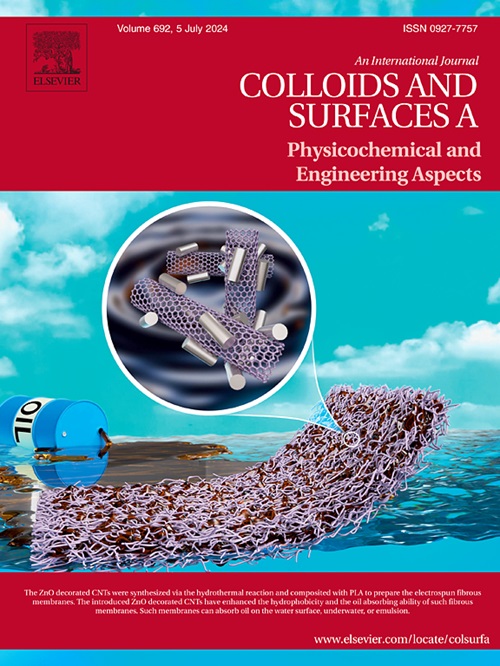MMTZ与羧酸聚合物的协同作用:提高电解铜箔的耐蚀性和抗氧化性
IF 4.9
2区 化学
Q2 CHEMISTRY, PHYSICAL
Colloids and Surfaces A: Physicochemical and Engineering Aspects
Pub Date : 2025-07-24
DOI:10.1016/j.colsurfa.2025.137830
引用次数: 0
摘要
电解铜(EC)箔在锂离子电池和印刷电路板中的广泛使用使得其耐腐蚀和抗氧化性对其性能和耐用性至关重要。然而,单一缓蚀剂的防护性能有限,凸显了对高性能复合缓蚀剂的迫切需求。在此,我们系统地研究了5-巯基-1-甲基- 1h -四唑(MMTZ)和羧酸聚合物(聚丙烯酸(PAA)、水解聚马来酸酐(HPMA)和马来酸-丙烯酸共聚物(MAAA))在提高EC箔耐腐蚀性和抗氧化性能中的协同作用。与单一缓蚀剂相比,复合缓蚀剂显著提高了EC箔的耐腐蚀性能和抗氧化性能。单独使用时,MMTZ和MAAA的缓蚀效率分别仅为83.99 %和44.76 %,而MMTZ-MAAA复合体系的缓蚀效率达到96.95 %,且在200℃时仍能显著延缓EC箔的氧化变色。XPS和分子动力学模拟结果进一步证实了羧酸抑制剂与MMTZ之间的协同作用。具体来说,这些成分通过空间互补的相互作用,在EC箔表面形成稳定而紧凑的保护屏障。本研究为设计高性能EC箔复合缓蚀剂提供了理论见解和新的方向。本文章由计算机程序翻译,如有差异,请以英文原文为准。
Synergistic interactions of MMTZ and carboxylic acid polymers: Enhancing the corrosion and oxidation resistance of electrolytic copper foil
The widespread use of electrolytic copper (EC) foil in lithium-ion batteries and printed circuit boards makes its corrosion and oxidation resistance critical to performance and durability. However, the protective performance of single corrosion inhibitors is limited, highlighting the urgent need for high-performance composite corrosion inhibitors. Herein, we systematically investigate the synergistic effects of 5-mercapto-1-methyl-1H-tetrazole (MMTZ) and carboxylic acid polymers (polyacrylic acid (PAA), hydrolyzed poly maleic anhydride (HPMA), and maleic acid-acrylic acid copolymer (MAAA)) in enhancing the corrosion resistance and antioxidant performance of EC foil. Compared to single corrosion inhibitors, composite inhibitors significantly improve the corrosion resistance and antioxidant performance of EC foil. When used individually, the corrosion inhibition efficiency of MMTZ and MAAA is only 83.99 % and 44.76 %, respectively, while the corrosion inhibition efficiency of the MMTZ-MAAA composite system reaches 96.95 %, and it can still significantly delay the oxidation discoloration of EC foil at 200°C. The XPS and molecular dynamics simulation results further confirm the synergistic effect between the carboxylic acid inhibitors and MMTZ. Specifically, these components interact to form a stable and compact protective barrier on the EC foil surface through spatially complementary interactions. This work offers theoretical insights and new directions for designing high-performance composite corrosion inhibitors for EC foil.
求助全文
通过发布文献求助,成功后即可免费获取论文全文。
去求助
来源期刊
CiteScore
8.70
自引率
9.60%
发文量
2421
审稿时长
56 days
期刊介绍:
Colloids and Surfaces A: Physicochemical and Engineering Aspects is an international journal devoted to the science underlying applications of colloids and interfacial phenomena.
The journal aims at publishing high quality research papers featuring new materials or new insights into the role of colloid and interface science in (for example) food, energy, minerals processing, pharmaceuticals or the environment.

 求助内容:
求助内容: 应助结果提醒方式:
应助结果提醒方式:


